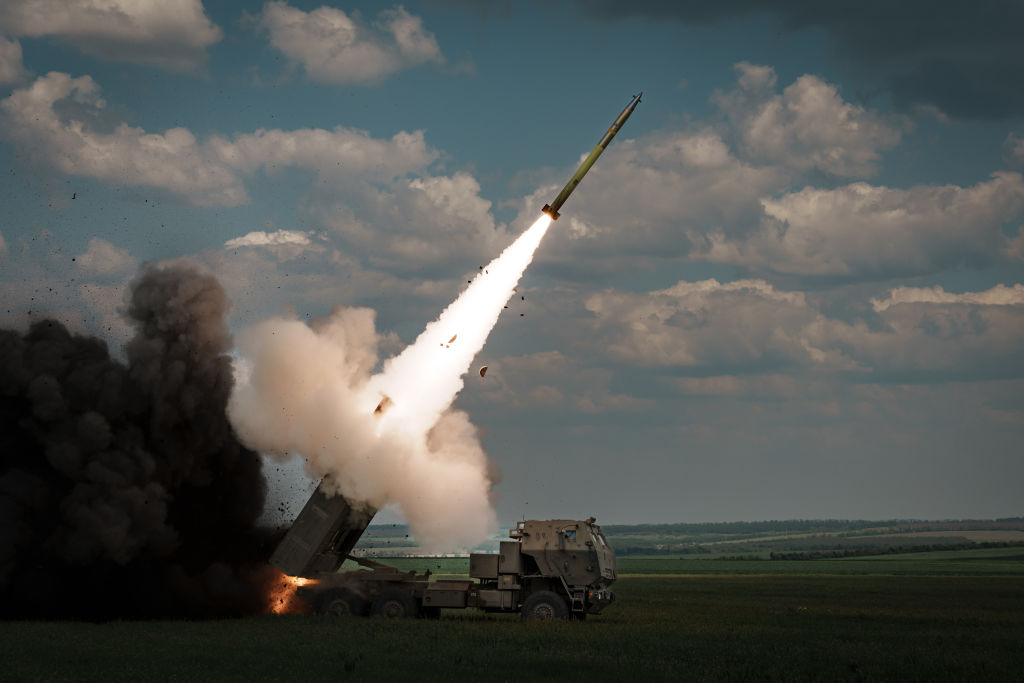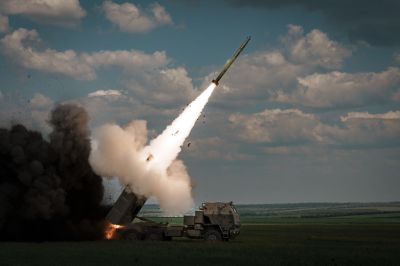President Joe Biden has declared the United States will support Ukraine in its war against Russia “for as long as it takes as it defends its sovereignty and territorial integrity.” But how any aid sent to Ukraine is appropriated, spent, and regulated is a convoluted and controversial procedure.
Since August 2021—following Russia’s initial military buildup along the Ukrainian border—the United States has provided $76.8 billion in aid to Ukraine, according to Kiel Institute for the World Economy. Of that, 61 percent ($46.6 billion) is military aid, 34 percent ($26.4 billion) is economic aid, and the remaining 5 percent ($3.9 billion) is for humanitarian aid.
But whether to send more has been a source of friction between some congressional Republicans and the Biden administration, and some Republicans are calling for more clarity on what costs Biden is willing to incur for “as long as it takes.” On November 3, the Biden administration announced new security assistance for Ukraine, totaling $425 million in previously allocated money. The administration is using the Presidential Drawdown Authority to send $125 million worth of inventory from Department of Defense stockpiles and allocated $300 million in Ukraine Security Assistance Initiative Funds to provide laser-guided munitions, which would exhaust the latter.
What is Presidential Drawdown Authority?
Presidential Drawdown Authority (PDA) allows the president to pull from existing Department of Defense stockpiles to send equipment to foreign countries or international organizations. Since it draws from existing supplies, it is available more quickly than other military aid, sometimes just days after it’s announced.
Congress increased the cap for PDA directed to Ukraine from $100 million to $11 billion in fiscal year 2022, following Russia’s invasion. This authority doesn’t expire at the end of the fiscal year, nor does it require approval from Congress as long as the administration hasn’t surpassed the allocated amount.
Since August 2021, the United States has sent equipment ranging from medical supplies and first aid kits to a Patriot air defense battery and munitions, High Mobility Artillery Rocket Systems (HIMARS) and ammunition, and hundreds of combat vehicles using PDA. In August 2023 the Defense Department revealed a previous accounting error that led to the overvaluation of weapons and equipment sent to Ukraine through previous drawdowns, restoring $6.2 billion to the available PDA funds. As of this month, Biden has just under $5 billion remaining in PDA funds available for Ukraine.
What is the Ukraine Security Assistance Initiative?
The Ukraine Security Assistance Initiative (USAI) is another funding source approved by Congress through which the U.S. can supply training and equipment to Ukraine, established in the 2016 National Defense Authorization Act. In 2020, before Russia’s most recent invasion, the USAI was allocated about $250 million, half of which was conditional aid tied to Ukraine’s progress on various defense reforms, such as strengthening civilian control of the military, increasing transparency and competition in defense contracts, and increasing internal controls to reduce corruption.
Since Russia’s invasion of Ukraine in February 2022, the USAI has been funded through various supplemental appropriations packages. In fiscal years 2022 and 2023, the USAI totaled $18 billion. In August 2023, the administration requested an additional $5 billion for USAI specific funds, as well as $10.5 billion in supplemental security assistance for Ukraine and other countries affected by the war.
Equipment funded through USAI requires contracts with U.S. defense companies to manufacture new military equipment, which it then sends to Ukraine. USAI-funded equipment has included National Advanced Surface-to-Air Missile Systems, HIMARS, Armored high Mobility Multipurpose Wheeled Vehicles, Puma unmanned aerial systems and support systems, and much more. USAI also funds the training, maintenance, and sustainment of the provided systems.
A drawback to USAI is that the announcement of new assistance marks the beginning of the contracting process, meaning this aid may not make it to the battlefield for months or even years after the announcement.
How does the U.S. track what happens to aid sent to Ukraine?
Congress has passed four spending packages worth $113 billion related to Ukraine since February 2022. The majority—54.7 percent—went to the Defense Department, with the United States Agency for International Development (USAID) and State Department receiving 32.3 percent and 8.8 percent respectively. The remaining 4.2 percent was divided among other agencies, including the Department of Energy, Department of Justice, and Department of the Treasury, among others.
Not all of the funds appropriated in these packages has gone to Ukraine. Congress appropriated $25.93 billion to restore Defense Department inventories depleted by PDA, and USAID used $300 million of the appropriated funds to help Moldova move away from dependence on Russian energy.
Within these packages, Congress appropriated $42 million for oversight initiatives in the Government Accountability Office (GAO) and the offices of the inspector general (OIG) for the Defense Department, Department of State, and USAID. The OIGs work together to target fraud, waste, and abuse in three primary areas: security, humanitarian and economic assistance, and diplomatic operations.
In January 2023, the three OIGs released their Joint Strategic Oversight Plan for Ukraine Response, outlining their focus on fraud, waste, and abuse in assistance sent to Ukraine, as well as overlap and waste in U.S. efforts to provide this aid—though the agencies have minimal staff in Ukraine to complete evaluations and audits.
In September the chair of the Council of the Inspectors General on Integrity and Efficiency, which oversees all federal OIGs, named Defense Department Inspector General Robert P. Storch as the lead inspector general for Operation Atlantic Resolve (OAR)—the operation encompassing combat-credible deployments in support of NATO efforts in Europe. Though Ukraine is not a NATO member, the OAR office is managing oversight of Ukraine assistance. This makes Storch, as well as the OIGs at the Department of State and USAID, responsible for oversight of all U.S. government activities in Ukraine.
Defense Department inspectors general historically inspected military equipment provided to Ukraine since the dissolution of the Soviet Union, though there was a pause in the immediate wake of Russia’s invasion when the United States closed its embassy in Kyiv. Site inspections resumed in October 2022, though with the additional difficulty of operating in an active conflict zone. Inspectors cannot inspect equipment at the frontlines, instead relying on Ukraine to self-report.
Oversight of financial and humanitarian assistance poses a different problem for Congress. In the last fiscal year USAID allocated $22.9 billion to support Ukraine’s central budget and helping the government pay its salaries, school employees, first responders, and health care workers. Yet in the same year, the State Department determined Ukraine did not meet fiscal transparency standards.
The U.S. funneled those funds through the World Bank, from which it requires reporting, but the U.S. does not control how the World Bank monitors the funds. The World Bank can deliver and implement grants quickly through existing systems and deliver funds from multiple donors efficiently. But it doesn’t allow for the United States to directly regulate the funds allocated to Ukraine.
Ukraine has historically struggled with government and business corruption, though it has made significant improvements since 2014. In August, Ukrainian President Volodymyr Zelensky fired all regional recruitment officers over allegations of corruption. In September, Defense Minister Oleksii Reznikov resigned amid investigations of corruption within the department, though Reznikov was not personally implicated. While corruption continues to plague Ukraine, the reforms are notable. Earlier this year, the European Council’s Group of States Against Corruption removed Ukraine from the list of “globally unsatisfactory” countries.
What oversight changes do Republicans want?
Republicans have yet to reach a consensus regarding aid to Ukraine. An increasingly isolationist wing of the Republican Party, which helped depose Kevin McCarthy as speaker last month under the auspices of a secret deal with the Biden administration to continue funding Ukraine’s war efforts, wants to stop funding Ukraine altogether.
Even those Republicans who support Ukraine have voted against aid recently, calling on Biden to define a clear plan for how continued aid from the U.S. will help Ukraine win its war against Russia.
Legislation was introduced in both the House and the Senate—by Rep. Chip Roy and Sen. Josh Hawley, respectively—to establish a special inspector general for Ukraine assistance (SIGUA), modeled after those set up for Iraq and Afghanistan. This would be the central oversight office for all military and nonmilitary aid to Ukraine, and would provide quarterly reports to Congress. The SIGUA would collaborate with the OIGs for the Defense Department, State Department, and USAID. Critics, such as Daniel Runde and Madeleine McLain at the Center for Strategic and International Studies, argue the SIGUA is yet another layer of bureaucracy, siloing oversight efforts already in place.
Most recently, House Republicans unveiled a proposal to tie Ukraine aid to U.S.-Mexico border security. The proposal would renew construction of walls along the border, and raise the “credible fear of persecution” threshold for asylum seekers, in exchange for additional appropriations for Ukraine. “If we’re going to protect Ukraine’s border, and we have to do what is necessary there, we don’t want Vladimir Putin to prevail, we can’t afford that, the free world can’t afford that, but we have to take care of our own border first,” Speaker Mike Johnson explained.






Please note that we at The Dispatch hold ourselves, our work, and our commenters to a higher standard than other places on the internet. We welcome comments that foster genuine debate or discussion—including comments critical of us or our work—but responses that include ad hominem attacks on fellow Dispatch members or are intended to stoke fear and anger may be moderated.
With your membership, you only have the ability to comment on The Morning Dispatch articles. Consider upgrading to join the conversation everywhere.